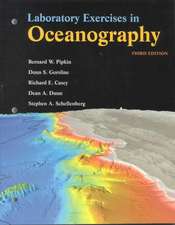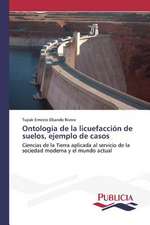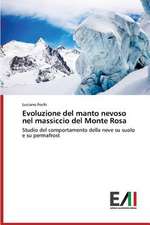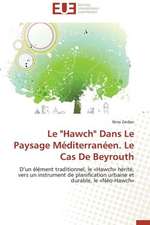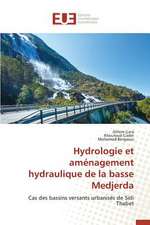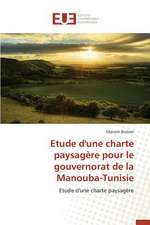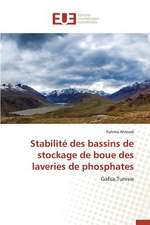The Essential Earth
Autor Thomas H. Jordan, John Grotzingeren Limba Engleză Paperback – 7 aug 2012
The Essential Earth is a whole new way to open students' eyes to the physical world around them, to learn how scientists explore it, and what we need to do to both protect ourselves from it (hazards) as well as protect it from us (global change). In just 14 chapters, it offers a well-focused introduction to the basics of geology that emphasize the process of science and how humans interact with our home, Spaceship Earth.
Preț: 477.26 lei
Preț vechi: 716.54 lei
-33% Nou
Puncte Express: 716
Preț estimativ în valută:
91.32€ • 95.54$ • 75.86£
91.32€ • 95.54$ • 75.86£
Carte disponibilă
Livrare economică 12-26 martie
Preluare comenzi: 021 569.72.76
Specificații
ISBN-13: 9781429255240
ISBN-10: 1429255242
Pagini: 505
Ilustrații: colour illustrations, maps
Dimensiuni: 231 x 272 x 23 mm
Greutate: 1.16 kg
Ediția:Revizuită
Editura: W. H. Freeman and Company
Locul publicării:New York, United States
ISBN-10: 1429255242
Pagini: 505
Ilustrații: colour illustrations, maps
Dimensiuni: 231 x 272 x 23 mm
Greutate: 1.16 kg
Ediția:Revizuită
Editura: W. H. Freeman and Company
Locul publicării:New York, United States
Descriere
The Essential Earth, Second Edition, opens students' eyes to the physical world around them and teaches them how scientists explore it. The book presents a well-focused introduction to the basics of geology that emphasizes the process of science and how humans interact with Earth. Key features include:
Chapter opening stories.
Students are introduced to new areas of coverage with stories of real people and real-life events that show the remarkable contributions of geology to our everyday lives.
Well-conceived art program.
The Essential Earth is filled with evocative photographs, including many of geologists at work. The illustrations are colorful and clearly labeled to help students visualized important geologic processes.
Coverage of topics students are already interested in.
The Essential Earth connects the course to headline-making issues such as global climate change, the use of natural resources, natural hazards and environmental issues.
Google Earth Projects
In order to create a more active, practical approach to learning the material, and to take advantage of a popular and useful multimedia resource, we have designed focused explorations of geologic locations using Google Earth.
Visual Literacy Tasks
The Second Edition continues to focus on active learning by enriching core graphics in unique and effective Visual Literacy Tasks. Created in collaboration with geology education researchers Karen Kortz and Jessica Smay, these brief exercises explore a key illustration or photo through a series of conceptual questions aimed at building a comprehensive understanding.
Chapter opening stories.
Students are introduced to new areas of coverage with stories of real people and real-life events that show the remarkable contributions of geology to our everyday lives.
Well-conceived art program.
The Essential Earth is filled with evocative photographs, including many of geologists at work. The illustrations are colorful and clearly labeled to help students visualized important geologic processes.
Coverage of topics students are already interested in.
The Essential Earth connects the course to headline-making issues such as global climate change, the use of natural resources, natural hazards and environmental issues.
Google Earth Projects
In order to create a more active, practical approach to learning the material, and to take advantage of a popular and useful multimedia resource, we have designed focused explorations of geologic locations using Google Earth.
Visual Literacy Tasks
The Second Edition continues to focus on active learning by enriching core graphics in unique and effective Visual Literacy Tasks. Created in collaboration with geology education researchers Karen Kortz and Jessica Smay, these brief exercises explore a key illustration or photo through a series of conceptual questions aimed at building a comprehensive understanding.
Cuprins
CHAPTER 1 Why We Study Earth
CHAPTER 2 How We Study Earth
CHAPTER 3 Plate Tectonics: The Unifying Theory of Geology
CHAPTER 4 Earth Materials: Minerals and Rocks
CHAPTER 5 Igneous Processes and Volcanism
CHAPTER 6 Sedimentation: Rocks Formed by Surface Processes
CHAPTER 7 Deformation and Metamorphism
CHAPTER 8 Timing the Geologic Record
CHAPTER 9 History of Earth
CHAPTER 10 The Climate System and Glaciation
CHAPTER 11 The Hydrologic Cycle and Groundwater
CHAPTER 12 Shaping Earth's Surface: Streams, Coastlines, and Wind
CHAPTER 13 Earthquakes and Earth Structure
CHAPTER 14 Human Impact on Earth's Environment
Notă biografică
THOMAS H. JORDAN is Director of the Southern California Earthquake Center, University Professor and W. M. Keck Foundation Professor of Earth Sciences at the University of Southern California, USA. As SCEC's principal investigator since 2002, he has overseen all aspects of its program in earthquake system science, which currently involves over 600 scientists at more than 60 universities and research institutions worldwide (http://www.scec.org). Jordan currently chairs the International Commission on Earthquake Forecasting for Civil Protection (appointed by the Italian government), is a member of the California Earthquake Prediction Evaluation Council and has served on the Scientific Earthquake Studies Advisory Committee of the U.S. Geological Survey. Jordan's research is focused on system-level models of earthquake processes, earthquake forecasting and forecast-evaluation, and full-3D waveform tomography. He is an elected member of the National Academy of Sciences, the American Academy of Arts and Sciences, and the American Philosophical Society.
JOHN GROTZINGER is the Fletcher Jones Professor of Geology at the California Institute of Technology, USA. He currently works as a geologist on the Mars Exploration Rover team, the first mission to conduct ground-based exploration of the bedrock geology of another planet, which has resulted in the discovery of sedimentary rocks formed in aqueous depositional environments. His research addresses the chemical development of the early oceans and atmosphere, the environmental context of early animal evolution, and the geologic factors that regulate sedimentary basins. He is a member of the American Academy of Arts & Sciences and the U.S. National Academy of Sciences.
JOHN GROTZINGER is the Fletcher Jones Professor of Geology at the California Institute of Technology, USA. He currently works as a geologist on the Mars Exploration Rover team, the first mission to conduct ground-based exploration of the bedrock geology of another planet, which has resulted in the discovery of sedimentary rocks formed in aqueous depositional environments. His research addresses the chemical development of the early oceans and atmosphere, the environmental context of early animal evolution, and the geologic factors that regulate sedimentary basins. He is a member of the American Academy of Arts & Sciences and the U.S. National Academy of Sciences.
Caracteristici
Designed to teach non-science students: Filled with clearly labelled photographs and illustrations as well as Visual Literacy Tasks - brief exercises which explore a key illustration or photo through a series of questions to build understanding
Engaging content: Makes connections to high profile issues such as global climate change, the use of natural resources, natural hazards and environmental issues
Real-life examples: Chapter opening stories introduce new areas of coverage with stories of real people and real-life event to highlight how geology contributes to everyday lives
Engaging content: Makes connections to high profile issues such as global climate change, the use of natural resources, natural hazards and environmental issues
Real-life examples: Chapter opening stories introduce new areas of coverage with stories of real people and real-life event to highlight how geology contributes to everyday lives

